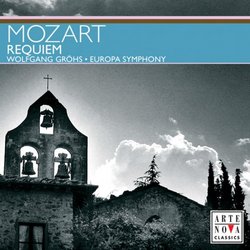| All Artists: Wolfgang Amadeus Mozart, Wolfgang Grohs, Europa Symphony, Stefanie Kopinits, Gerhard Horl Title: Mozart: Requiem Members Wishing: 0 Total Copies: 0 Label: Arte Nova Classics Original Release Date: 1/1/2006 Re-Release Date: 11/14/2006 Genre: Classical Styles: Opera & Classical Vocal, Historical Periods, Classical (c.1770-1830), Early Music, Symphonies Number of Discs: 1 SwapaCD Credits: 1 UPC: 723721175351 |
Search - Wolfgang Amadeus Mozart, Wolfgang Grohs, Europa Symphony :: Mozart: Requiem
 | Wolfgang Amadeus Mozart, Wolfgang Grohs, Europa Symphony Mozart: Requiem Genre: Classical
Mozart's final composition, the Requiem, remains one of his most beloved works and one of the great choral works of all time. This fresh, inspiring performance features middle-European artists whose talents were long ob... more » |
Larger Image |
CD Details
Synopsis
Album Description
Mozart's final composition, the Requiem, remains one of his most beloved works and one of the great choral works of all time. This fresh, inspiring performance features middle-European artists whose talents were long obscured behind the Iron Curtain. Immediately after its foundation (in 1992 as the "Philharmonia Romania" by its principal conductor, Wolfgang Gröhs), critics praised the Europa Symphony for its extraordinary sonority and transparency, as well as its well balanced sound and dynamic. The orchestra is composed of the best Romanian orchestral musicians and benefits from support by the Austrian government. Since 1994, the orchestra has been known by the name of Europa Symphony, indicating on one hand its international alignment and on the other hand expressing its intense collaboration with artists and orchestra instrument players of the whole of Europe. The orchestra plays periodically in Romania, participates in numerous festivals, and collaborates with soloists of international reputation.

 Track Listings (12) - Disc #1
Track Listings (12) - Disc #1